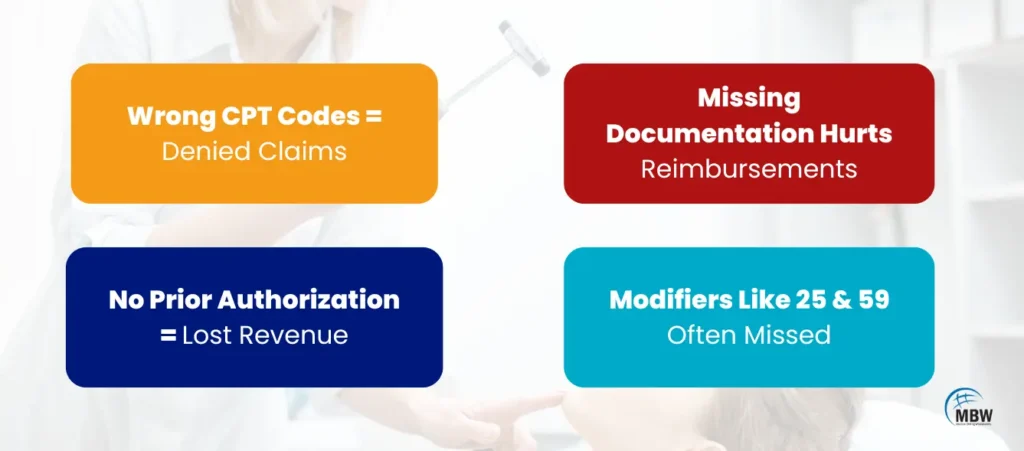Neurology billing and coding services are highly specialized and demand near-perfect execution. Even a minor error in code selection or payer policy adherence can lead to claim denials, payment delays, and audits.
According to MGMA, nearly 30% of all medical claims are initially denied, and neurology ranks among the specialties most impacted due to its procedural complexity.

Let’s explore the 10 most common billing and coding challenges in neurology—and more importantly, how your practice can tackle each one effectively.
1. Why Are Neurology CPT Code Errors Leading to Claim Rejections?
One of the most frequent reasons for claim denials in neurology is the use of outdated or inaccurate CPT codes. These codes are frequently revised by the American Medical Association, and using last year’s version in this year’s submission will often result in an instant rejection.
| CPT Code | Description |
|---|---|
| 95819 | Routine EEG with interpretation |
| 96132 | Neuropsychological testing evaluation |
| 95970 | Electronic analysis of neurostimulator |
| 99205 | New patient visit, high complexity |
How to fix:
Subscribe to official coding updates and conduct regular internal reviews. You can also streamline accuracy by partnering with experienced professionals in neurology billing and coding services who stay updated with specialty-specific revisions.
2. How Does Missing Documentation Impact Neurology Billing?
Incomplete patient records—such as missing clinical notes, unsigned reports, or unsupported diagnoses—cause up to 50% of neurology claim rejections. Without proper documentation, even accurate coding won’t hold up under payer scrutiny.
What You Can Do:
Build a documentation protocol within your EMR system that alerts providers to missing elements. Require same-day finalization of notes and run weekly audits to track compliance. Our insights on addressing coding denials offer practical ways to tighten your documentation workflow.
3. What Happens When Neurology Modifiers Are Misused or Missed?
Modifiers clarify procedures performed in tandem or separately. Misusing or forgetting to apply essential modifiers like 25 and 59 can result in bundling issues or denials.
Suggested Fix:
Introduce modifier prompts in your EHR based on procedure groupings. Train billing teams on common payer-specific modifier rules. Regularly audit denied claims to identify trends in modifier usage and correct course proactively.
4. How Do Overbilling and Underbilling Affect Neurology Practices?
Incorrect E/M level selections—often due to subjective interpretations of patient complexity—can result in audits, refunds, or lost revenue. Overbilling raises compliance red flags, while underbilling leaves revenue on the table.
Next Steps:
Use automated E/M calculators built into your billing system to remove guesswork. Conduct quarterly comparative reviews across providers to flag patterns. Emphasize coding accuracy in team training rather than speed.
5. Why Do Neurology Claims Get Denied Due to Prior Authorization?
Procedures like nerve conduction studies, MRIs, and advanced therapeutics often require prior authorization. Without it, practices risk unpaid claims even if the service is medically necessary.
Solution Strategy:
Establish a checklist-driven pre-certification process. Use color-coded scheduling tools to identify services that require authorization. Assign a dedicated coordinator or outsource to a billing service that handles high-volume prior auth requests efficiently.

6. Can Duplicate Billing Errors Be Avoided in Neurology?
Yes, and they must be. Duplicate billing typically results from system-generated claims or duplicate charge entries. These errors create administrative overhead and trigger payer flags.
Preventive Tip:
Enable duplicate detection tools in your claims management software. Foster team collaboration between front-desk and billing departments to eliminate data entry overlaps. Review end-of-day claims summaries to catch repeat entries before submission.
7. How Does Insurance Verification Prevent Neurology Billing Denials?
According to industry data, 1 in 5 claims is denied due to eligibility issues—such as expired plans, wrong coverage types, or in-network limitations. These rejections are easily preventable.
Recommended Fix:
Adopt real-time verification tools through clearinghouses. Make insurance validation a non-negotiable checkpoint at both appointment scheduling and check-in. Log verification confirmations for future payer audits.
8. Are Telehealth Billing Errors Still a Problem in Neurology?
Telehealth coding remains complex. Neurologists often use codes like 99443 and G2061, but incorrect modifiers or the wrong place of service code frequently result in denials.
How to Stay Ahead:
Keep a dynamic billing policy that aligns with CMS and commercial telehealth rules. Use EMR templates tailored to tele-neurology. Re-train staff quarterly to reflect policy updates. Proper use of POS 02 or 10 and Modifier 95 is crucial for reimbursement.
9. Why Is Poor Denial Management a Revenue Killer in Neurology?
About 60% of denied claims are never resubmitted, often due to staffing shortages, lack of follow-up systems, or poor visibility into denials. This leads to substantial revenue leakage.
| Reason for Denial | Percentage |
|---|---|
| Missing documentation | 50% |
| Incorrect coding | 30% |
| Never resubmitted | 60% |
How to Fix It:
Invest in a denial tracking system. Segment your denials by root cause and assign them to focused teams for appeal or correction. Conduct weekly denial resolution meetings to maintain accountability across departments.
10. What’s Different About Pediatric Neurology Billing?
Pediatric neurology involves age-specific procedures and ICD-10 codes. Using adult-focused coding frameworks results in misclassification and delayed payments.
Fix It Fast:
Develop pediatric-specific templates in your EHR. Assign billing staff trained in pediatric coding or collaborate with specialists. For more insights, explore our full guide on understanding neurology billing and coding to identify what sets pediatric billing apart.
Conclusion
Billing and coding in neurology isn’t just administrative—it’s foundational to a practice’s financial performance. With complex CPT codes, modifier requirements, payer-specific rules, and telehealth trends, the margin for error is thin. But with proactive audits, payer policy tracking, and specialized workflows, neurology practices can protect their revenue and reduce denial rates dramatically.
According to industry benchmarks, practices that fine-tune their billing and coding approach can increase clean claim rates by 20% or more within 6 months.
Ready to Stop Losing Revenue from Billing Errors?
Let our neurology billing experts handle coding updates, denial appeals, prior authorizations, and more—so you can focus on patient care.
👉 Talk to our team today and discover how we help neurology practices eliminate billing errors and improve collections—consistently.


